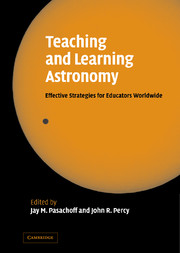Book contents
- Frontmatter
- Contents
- List of illustrations
- Preface
- Introduction
- Part I Astronomy in the curriculum around the world
- Part II Astronomy education research
- Part III Educating students
- Part IV Educating teachers
- Introduction
- 10 Pre-service astronomy education of teachers
- 11 In-service astronomy education of teachers
- Poster highlights
- Part V Astronomy and pseudoscience
- Part VI Astronomy and culture
- Part VII Astronomy in developing countries
- Part VIII Public outreach in astronomy
- Part IX The education programs of the International Astronomical Union
- Part X Conclusions
- Author index
- Subject index
Introduction
Published online by Cambridge University Press: 18 May 2010
- Frontmatter
- Contents
- List of illustrations
- Preface
- Introduction
- Part I Astronomy in the curriculum around the world
- Part II Astronomy education research
- Part III Educating students
- Part IV Educating teachers
- Introduction
- 10 Pre-service astronomy education of teachers
- 11 In-service astronomy education of teachers
- Poster highlights
- Part V Astronomy and pseudoscience
- Part VI Astronomy and culture
- Part VII Astronomy in developing countries
- Part VIII Public outreach in astronomy
- Part IX The education programs of the International Astronomical Union
- Part X Conclusions
- Author index
- Subject index
Summary
Teachers are the key element in effective teaching and learning of astronomy. Yet very few teachers have any background in astronomy or astronomy teaching. At the elementary school level, very few teachers have any background in science at all. How much astronomy should teachers know? How should they learn it? This leads to another important issue: many teachers, especially at the elementary level, have science and mathematics “anxiety,” and may transmit this anxiety to their students. It's important for teachers to have and transmit interest and enthusiasm. How can these desiderata be built into pre-service teacher education?
In Chapter 10, Mary Kay Hemenway addresses the complex topic of pre-service teacher education. Like the curriculum, teacher education varies greatly from one country to another, and even within a single country.
There are two models of teacher education: concurrent and sequential. In the concurrent model, teachers receive their content courses and pedagogy courses concurrently. The advantage is a greater integration of content and practice. In the sequential model, teachers receive a regular undergraduate degree along with hundreds of other students who are generally not prospective teachers. It may be very frustrating for prospective teachers to take science courses that are taught by the traditional lecture, textbook, and regurgitation exam method, and then to learn in teachers' college that this is not a very effective approach and that, further, this method is rarely used in schoolteaching! Of course, one of the great anomalies of the education system is that college and university instructors seldom receive any pre-service or in-service training in teaching and learning.
Information
- Type
- Chapter
- Information
- Teaching and Learning AstronomyEffective Strategies for Educators Worldwide, pp. 137 - 138Publisher: Cambridge University PressPrint publication year: 2005
